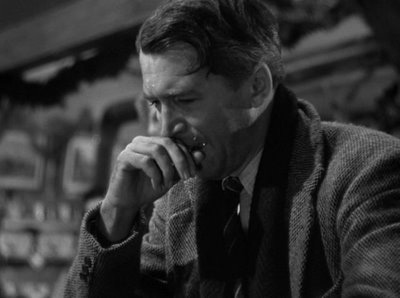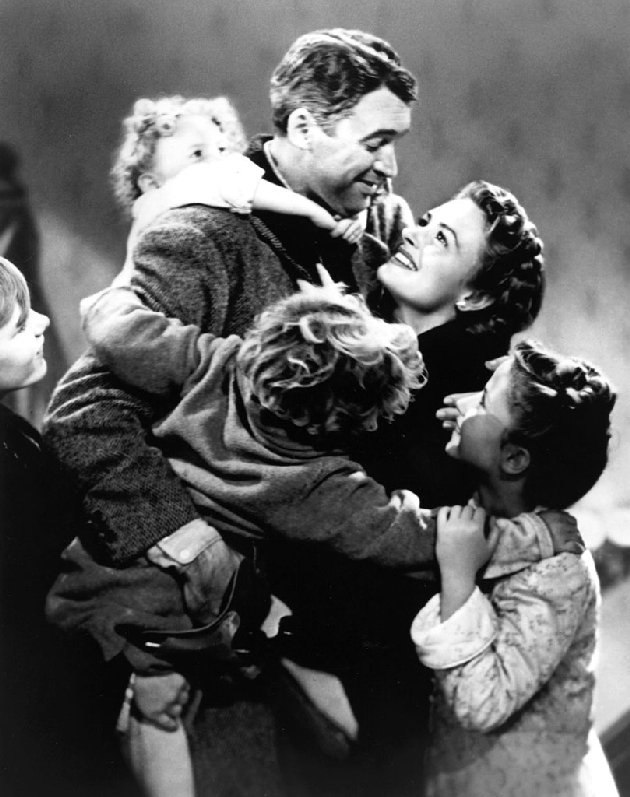Committed to the First Amendment and OUR Freedom of Speech since 2008
It's a Wonderful Life

A Story Told and Many Lessons Learned ... Merry Christmas and Thank-you Frank Capra
The word classic gets thrown around too often when describing art of some measure of quality and it cheapens its
 credible effect. Without falling prey to the misdeeds of others, the great film of our childhood and children’s childhood and I dare say our children’s children’s childhood is the classic film “It’s a Wonderful Life.” Its is considered a Christmas season film, but, yearlong its clarion message resonates with folks who care about community and family.
credible effect. Without falling prey to the misdeeds of others, the great film of our childhood and children’s childhood and I dare say our children’s children’s childhood is the classic film “It’s a Wonderful Life.” Its is considered a Christmas season film, but, yearlong its clarion message resonates with folks who care about community and family.
The film “It’s a Wonderful Life” was taken in part from the story “The Gift” written by Phillip Van Doren Stern. It was released in the year following World War II to a people who really needed a story that represented the despair and great loss that was encumbered upon them, and yet it all worked out in the end because of the generosity of others. Director Frank Capra knew that he had a winning story and all he needed to propel it into the consciousness of America was a solid cast with excellent chemistry, which he got from: Donna Reed as the perfect wife, Mary Bailey, Thomas Mitchell as the dotty Uncle Billy Bailey, Henry Travers as the dimwitted Guardian Angle working diligently to earn his wings, journeyman Ward Bond as Bert the Cop and Lionel Barrymore as the irascible Henry F. Potter, who was terribly mean and should have at least been nominated for the Oscar, if not its winner, for Best Supporting Actor. Fold in the very popular Jimmy Stewart in the lead Role of George Bailey, who had won an Oscar for Best Actor in a Leading Role in the film “Philadelphia Story” in 1940 just before he enlisted in the U.S. Army Air Corp, and you have the potential for a successful film - maybe a classic.
“It’s a Wonderful Life” is, without argument, the most memorable film from 1946. The story of an angel on Christmas Eve offering a mere mortal the opportunity to see what his community, Bedford Falls, would have been like if he had never lived is not all together original. Charles Dickens’s “A Christmas Carol” was similar in that Ebenezer Scrooge was visited at three separate times by three successive spirits on Christmas Eve, however, that is where the similarities end. No ghoulish spirits visited anyone in Bedford Falls on Christmas Eve, just the doddering guardian angel without wings, named Clarence, pulling George out of the icy drink after he jumped off the local bridge, willing to end it all after perceiving himself a miserable failure. Clarence not only saves George, he incidentally saves Bedford Falls, because without the generous George Bailey his town would have been a much poorer place.
To date, I can’t remember scenes from a film that more exemplifies the infamous “run on the bank”
 event that resulted from the initial days of The Great Depression; than from the streets of Bedford Falls and the cramped upstairs confines of the Bailey Brothers Building and Loan. That day, the frightened shareholders / depositors of that establishment were enticed by the magnanimous George Bailey to receive small loans from the 2,000.00 that he saved for his and Mary’s Honeymoon rather than clean out their accounts that day of the “bank run.” Not only was it a perfect fit for this movie to show how the selfless George Bailey would help his community in desperate situations but lent an historical perspective to a time in America when neighbors shared an economic fear and pain would last for nearly 10 years. Men and women, like George Bailey, would save America in those distressed days by the sheer force of their love of community and their noble selflessness.
event that resulted from the initial days of The Great Depression; than from the streets of Bedford Falls and the cramped upstairs confines of the Bailey Brothers Building and Loan. That day, the frightened shareholders / depositors of that establishment were enticed by the magnanimous George Bailey to receive small loans from the 2,000.00 that he saved for his and Mary’s Honeymoon rather than clean out their accounts that day of the “bank run.” Not only was it a perfect fit for this movie to show how the selfless George Bailey would help his community in desperate situations but lent an historical perspective to a time in America when neighbors shared an economic fear and pain would last for nearly 10 years. Men and women, like George Bailey, would save America in those distressed days by the sheer force of their love of community and their noble selflessness.
“Remember no man is a failure who has friends.” Clarence inscribed in an edition of “Tom
 Sawyer” for a thank-you to George for helping him get his wings and to re-enforce that George need remember that he, if nothing else, is a selfless man of the community. Having friends was George Bailey’s saving grace at a very difficult time in his life, however, this not the moral of this tale. It was the gracious and selfless life that George led, which made others love him. Only Jimmy Stewart could have pulled off this role so effortlessly. As a man, as well as an actor, he was an extraordinary man who was incredibly capable at appearing ordinary.
Sawyer” for a thank-you to George for helping him get his wings and to re-enforce that George need remember that he, if nothing else, is a selfless man of the community. Having friends was George Bailey’s saving grace at a very difficult time in his life, however, this not the moral of this tale. It was the gracious and selfless life that George led, which made others love him. Only Jimmy Stewart could have pulled off this role so effortlessly. As a man, as well as an actor, he was an extraordinary man who was incredibly capable at appearing ordinary.
In regards to Stewart, I can not divorce the actor from the man, who as the commander and at the rank of captain, he led the 703rd Bombardment Squadron’s group of B-24 (Liberators) in over 20 missions deep into Nazi occupied Europe, and received, among many decorations for valor, the Distinguished Flying Cross twice. After nearly 5 years of service to his country, Stewart mustered out at the rank of colonel - the highest rank of any actor to fight for his country in WWII. The most significant aspect of Stewart’s service record as it relates to the film, “It’s a Wonderful Life,” is that it is his first movie upon his return to the states. One can only wonder how the most terrible war in the history of the world had changed the all American boy from Indiana, Pa., and to what extent did his war experience influence how he delivered George Bailey to his audience? The critics who reviewed this film in 1946 mostly panned the film; said it was too dark because of the attempted suicide of George, which led to its demise at the box office, and sadly, put director / financier Frank Capra out of the movie business for good. What a waste. Thankfully Jimmy Stewart went on to have a tremendous career as a male lead and as a character actor, and lived long enough to see Frank Capra’s film become one of the most popular from its era and a Yule Tide staple.

ZuZu Bailey with her dried rose petals (ZuZu Petals) as George is about to come totally unhinged: Above. George and his family reunited after George's guardian angel, Clarence, helps George see his life clearly within the context of helping others in his hometown of Bedford Falls: Below.

Classic movies, such as “It’s a Wonderful Life,” often are misunderstood by the present popular culture and film critics are sometimes more impressed with the projection of their intellectual capital than they are at espousing a well considered, heartfelt, subjective opinion, which is all a proper film review consists of. “It’s a Wonderful Life” is the perfect example of how some great films are under appreciated, and conversely, others that are critically well received diminish with time. Why? Obviously folks, on occasion, are herded into “group think” and get it wrong.
This is also why I will continue to give my heartfelt, subjective opinion and I pray it will aid you in taking a chance on a really great film, like “It‘s a Wonderful Life,” which I strongly recommend at 4 ½ stars, and missing other overrated movies altogether. It’s all a matter of how much quality time do you have to expend, and at just 132 minutes of runtime, your family should enjoy their time together watching “It‘s a Wonderful Life.”
Released in 1946. Not Rated.
Comments
|
I may be at the risk of over analyzing the distinction. Ray built the baseball field not know why, and travelled to Boston not knowing why, eventually finding himself in Minnesota not knowing why. He picked up a stranger only to find that the stranger had the same name he thought he heard at Fenway Park. When he returned no one in his hometown thought he was sane. He sounds like a Democrat.
They did eventually come and everyone came from miles around to see the ghost play. Now here is the distinction. He did all this with his own money. He did not build the park on his neighbor's farm. He did not appropriate the funds from his neighbors. He may sound like a Democrat but he acted like a Republican Capitalist. If he followed Terrance Mann's advice, his investment was rewarded: "Of course, we won't mind if you look around," you'll say. "It's only twenty dollars per person." They'll pass over the money without even thinking about it. For it is money they have and peace they lack. Perhaps there is another distinction. Like Frank Capra illustrated in Mr. Smith and A Wonderful Life, the determination is based on the faith on one person and not the collective imagination of the whole crowd. If I do say so myself, that's not bad for an early morning (thought not as early as the publisher -see 2:41 AM in his comment) two coffee psychoanalysis of a work of fiction. Others can feel free to shoot holes into my explanation of a work of fiction and fantasy. After all most of us are not switch hitters who can bat both from the left and the right. This comment is not the first time I have over analyzed this movie: beaufortcountynow.com |
|
"Field of Dreams" was such a successful film that it spawned the phrase that I heard far too often from far too many many ridiculous moderates /liberals in nearly all my years as a county commissioner - "If we build it, they will come". This infamous and silly cliche rang hollow so often, and believe me, I did my best to convey my belief, and yet, they kept saying it over and over so much that the phrase for this county commissioner that it became the next: "Can't you just do it for the children" for me.
Yes, "Field of Dreams" worked as a film, and, therefore, well worked its way into the American lexicon to my continual distraction. |
|
Another one is Field of Dreams (1989) which is almost 30 years old. If you can just suspend belief for a couple of hours wondrous things can happen.
I just saw a replay of the 25th anniversary show where Bob Costas interviews Kevin Costner in 2014. Somewhere in the show Kevin relates an encounter between a critic and director Phil Alden Robinson. My paraphrase of the exchange is" A critic says somewhat smugly "You do realize that Shoeless Joe Jackson batted left-handed and Ray Liotta bats right-handed in the movie?" Phil replied in a way that could only but us congenital fact checkers in our place. "If I can convince just a part of the audience that dead baseball players can come back to life, I think they will forgive which side of the plate he batted from!" Cha-Ching!!! If you can find the whole show it is well worth watching. Here is a clip courtesy of the Video Search on BCN. beaufortcountynow.com |
|
Thank-you Bobby Tony for these ongoing nuggets of real information.
"It's a Wonderful Life" is one of those films that exceeded the cinematic limits of its times, and a great film was made. This happened many times in that era, when film was in its infancy, and not many from that era, spanning decades, just could did not pass the test of time because of those limitations. "It's a Wonderful Life" is so wonderful, and it delivers just what Director Capra wanted - goodness expressed as a way of living. Having said all of this about the cinematic limits of the times - Beginning with "Gone with the Wind" and "Wizard of Oz", both from 1939, there began some great films that do pass muster as great classics. Even in the 1970's, when there were so many really poorly made films, by today's standards, and yet, both "Godfather" classics were made in the 1970's. Frank Capra and Jimmy Stewart are wise to consider "It's a Wonderful Life" a golden expression of a beautiful story. |
|
Here is an excerpt from Roger Ebert's belated review in 1999. I particularly like the last line by Frank.
"The best and worst things that ever happened to "It's a Wonderful Life" are that it fell out of copyright protection and into the shadowy no-man's-land of the public domain." "That was the best thing that happened to "It's a Wonderful Life," bringing cheer into the lives of director Frank Capra and star James Stewart, who both consider it their favorite film. The worst thing--which has inspired Stewart to testify before a congressional committee and Capra to issue a sickbed plea--is that the movie has been colorized. Movies in the public domain are so defenseless that you could cut one up to make ukulele picks, and who could legally prevent you? And so a garish colorized version--destroying the purity of the classic original black-and-white images--has been seen on cable, is available for local syndication and is sold on cassette." "It's a Wonderful Life" did little for Frank Capra's postwar career...At a seminar with some film students in the 1970s he was asked if there were still a way to make movies about the kinds of values and ideals found in the Capra films. "Well, if there isn't," he said, "we might as well give up." www.rogerebert.com |
|
God Bless Wyatt's soul and praise the Lord that goodness finds its way into our hearts.
|
|
A must watch every Christmas, along with Christmas Story. There are still places like Bedford Falls and people like George Bailey, but apparently Hollywood does not have any more Frank Capras.
Wyatt's unique perspective and delivery will continue to inform and uplift though he has passed to his reward. Thanks for re-posting. |























Ray sounds a lot like Abraham doesn't he, or: Was it Noah? Maybe, it was Moses.
In other words: "Nothing worthwhile was accomplished without a great deal of enthusiasm", and a little prodding.
Now, I am prodding you, because your last comment was one of the most inciteful that I have ever read on BCN, and you have written many that were.